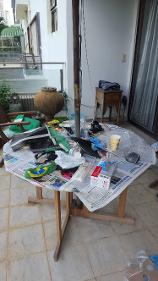I added reflections to bring back some high frequencies, and then applied some reflection dampening to reduce low mid warmth. But the greatest change comes from mass loading. Essentially increasing baffle rigidity using more than just dynamat. This helps dampen excess vibration in the whole structure at low frequencies, and it also helps offset the strength of the magnetic field for more precise control of the diaphragm at these frequencies. As a result, there is more transparency across the board.
My Z7 will most likely get measured against the stock pair soon. Will work on it even more when I get it back, as the current version is still just a test bed for this new mass loading mod. Originally, I used blu-tack and dynamat for this task, but I have since resorted to more... extreme materials.
I was hesitant to state anything, since theory may not always become reality, but impressions from other Head-fi'ers who have heard the first few prototypes gave me more confidence in the applicability of this mod. Purk currently has my pair, and he thinks it is very obviously different from stock where transparency and soundstaging are concerned. If we meet in the summer, I can give you a full breakdown, and you can also listen for the effect.
I agree with you, mass damping is the most important thing to do for me if you use plastic or aluminium as a material for cup and baffle. Wood on the other hand need little or none mass damping because the resonance of wood cause coloration that is frequently desirable. I would love to hear more from you about the "extreme material"
Now time for some more pics:

I made the cable from Double Helix Cable Nucleotide, Switchcraft 3.5mm jack (so I can use with my dx90 conveniently) and rean tiny XLR. For mini XLR, I think Rean is a good choice for it's aesthetic and affordability. The terminals are easy to solder. I use a plastic sleeving for speaker cable, similar to Techflex, but more coarse, you can see the braiding through the sleeves.

A clear shot oy the yokes assembly. The stock yoke from the Superlux HD660 is too small (the same size as Beyerdynamics), so I made a new yoke from stainless steel.I cut the shape from 2mm steel plate, then grinded and polished by dremel.
The hinge of the yoke (small rectangular plastic thing) is 3d printed from carbon fiber abs, glued on to the yoke. Then I use M3 socket head screw to attach the yoke to the cup.

There are 3 holes near the mini xlr connector. I designed the cups with vents at the front, but I need to drill extra 3 holes for tunning.

I used similar method to the Denon Markl mod, adding foam to the thicker side of the pads and cotton to the thinner side. It just sound good to my ears in this config. Also note the 2 holes I punched out of the earpads, helps thinning the mid.

The naked shot: the baffle is 3d printed from 3 parts, saving me from printing in 1 go and spend days removing the supporting materials. THe white blutack is there to mass damp the baffle and reduce reflection from the driver. There are small vents connecting to the main cup chamber. this reduces the pressure and again helping the soundstage, but too many open vents and the sound becomes thin with peaky treble.
There is also a lip for mounting the Audeze earpads.

Final pics showing the beautifull hd800 driver and my crappy craftsmanship with lots of blu-tack























 But definitely it's on my next do to list
But definitely it's on my next do to list 